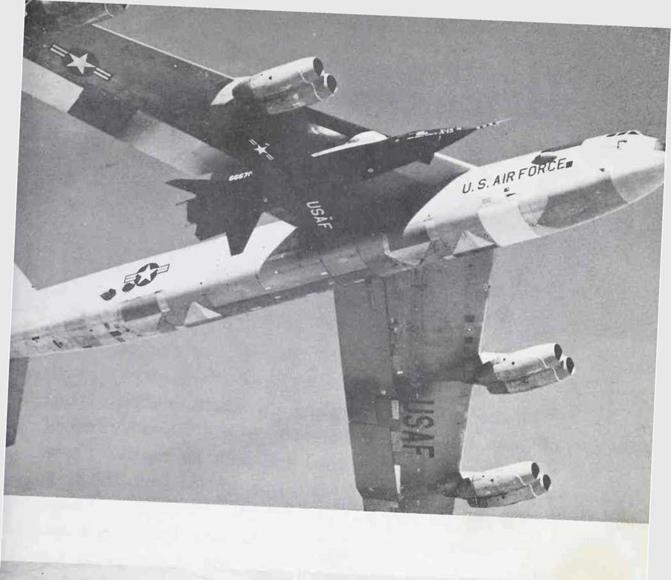THE EXPERIMENTALS
The United States Government approved a Research Airplane Program in 1944. The first in the series of pure research aircraft, the X-i, was launched in 1946. The “X” in the name of the plane means experimental.
The X-15, shown in the photos, is a small rocket-powered aircraft. On June 8, 1959, the X-15 made its first flight after being dropped from the protective wing of a B-52. In a decade of flight that ended in 1969, the X-15 reached heights and speeds that are still unmatched by any other aircraft. The X-15, f°r example, reached a peak altitude of more than sixty-seven miles. And on October 3, 1967, an X-15 was flown at a speed of 4,520 miles per hour, which is the equivalent of Mach 6.7.
At heights of sixty-seven miles, the X-15 was traveling above the effective atmosphere. Thus, the X-15 collected information on flights in air and space. By flying to the frontiers of space, the X-15 tested the effects of weightlessness on human pilots. The X-15 research program also demonstrated the ability of human pilots to fly high-powered aircraft with great accuracy.

|
|
|





Another research superplane, the XB-70, is shown taking off from Edwards Air Force Base in California. Two of these planes were developed and built for the Air Force. The XB-7o’s delta wing has a span of 105 feet. The fuselage is 185 feet long and 30 feet high.
The XB-70 has a long, pencil-like nose. Stubby horizontal stabilizers are located on each side of the plane just behind the cockpit. In the photo you can see the shadow cast by a stabilizer. The shadow reaches to and below the E in the word FORCE.
The delta wings of the XB-70 extend all the way to the tail section of the plane. Twin vertical stabilizers rise from the rear of the wings. Below the wings the exhaust pipes of the plane’s six engines can be seen.
The XB-70 has a range of 7,500 miles. It was designed to fly above 70,000 feet at speeds of 2,000 miles per hour, which is equivalent to Mach 3. The plane was used extensively to study the stability, control, and handling characteristics of large supersonic aircraft.
The YF-12A is shown in the photo below. This plane is an experimental long-range interceptor that was nicknamed the Blackbird, It was developed for defense against supersonic bombers and airborne missile launchers. The Blackbird flies above 80,000 feet at a speed of Mach 3, which is more than
2,0 miles per hour.
The Air Force and the National Aeronautics and Space Administration (NASA) are using the YF-12A in a joint research program. An important part of the program is concerned with flight management and air-traffic control. The researchers are studying the ability of the plane to maintain a precise altitude at supersonic speeds.










